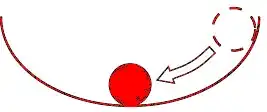I do understand that in the case of mechanics for example, if there is a soccer ball inside a "well", at mechanical equilibrium, the ball will be at the bottom of the well.

(source: utk.edu)
This is a consequence, of the fact that the potential has a minimum there. By definition, the force (derived from this potential) acting on the ball will make the ball go at the bottom for small fluctuations around equilibrium position.
But in the case of $E(S,V,N)$, I don't see where is the "force" that will keep E at the minimum for small fluctuations of $S,V$ and $N$.
Actually, the following section of my course does the following to define equilibrium:
$$\frac{\partial E}{\partial S} =T$$
$$\frac{\partial E}{\partial V} =0$$
$$\frac{\partial E}{\partial N} =0$$
Thank you for reading.